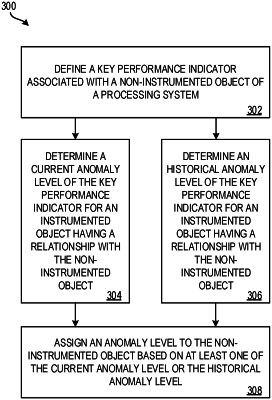| CPC G06F 16/2365 (2019.01) [G06N 20/00 (2019.01); H04L 63/1425 (2013.01)] | 14 Claims |

|
1. A computer-implemented method comprising:
defining a key performance indicator associated with a non-instrumented object of a processing system, wherein the non-instrumented object comprises an object of the processing system that does not have log data or metrics available for analysis;
determining, by a processing device, a current anomaly level for each of a plurality of key performance indicators for an instrumented object having a relationship with the non-instrumented object, wherein the instrumented object comprises another object of the processing system that has at least one of log data and metrics available for analysis;
assigning, by the processing device, an anomaly level to the non-instrumented object based on the current anomaly levels of the instrumented object, the anomaly level comprising a weighted function of the respective anomaly level of each of the plurality of key performance indicators, wherein each anomaly level is uniquely weighted;
for each type of non-instrumented object, normalizing the anomaly level for the respective type of non-instrumented object to a respective fixed scale, thus preventing key performance indicator-specific characteristics from influencing rankings of anomaly levels across non-instrumented components;
calculating, by the processing device, a confidence score for the anomaly level based at least in part on the relationship between the non-instrumented object and the instrumented object and based at least in part on a relationship between the non-instrumented object and other instrumented objects, wherein the confidence score is further based at least in part on a number of the relationships between the non-instrumented object and other instrumented objects; and
assigning the confidence score to the anomaly level assigned to the non-instrumented object.
|